I like to make things. Scott and I talked about it on a recent
podcast. When I was much younger, I used to build model kits
(airplanes, tanks, etc.). Later, when living on my own, I built a
lot of LEGO kits as well as model railroad stuff. I've played with
CNC, and have plans for a 3d printer. Building physical items lets
your mind exercise something slightly different from what you use
when you code. The added benefit of having an actual device in-hand
at the end is huge.
One thing I really like these days is building electronic kits.
I don't like any old electronic kit: the commercial LED blinkers
and amps don't hold my interest for long. However, synthesizer kits
really do. I've built a number of small synthesizer kits over the
past year or two, and thought I might mention them here.
There are lots of "building block" PCBs you can get out there,
as well as general noisemaker things like the Atari Punk Console
and cool items from places like Synthrotek, but I'm going to focus
this post just on kits that I think anyone who can solder can build
and then make music with. Let's start with fun little tabletop
synthesizers.
Tabletop Synthesizer Kits I've found
I prefer rackmount kits because they take up less desk space,
but most DIY synthesizers are of the tabletop variety. Tabletop
kits are more accessible to most folks, and easier to sit on top of
a keyboard controller or other synthesizer at your home. You could,
of course, build your own racks to house them, but I prefer to
build them as designed, in their own little cases. Here are a few
that I've run across or personally built. Most of them are Open Source Hardware, which is
truly awesome.
Meeblip SE and Meeblip Micro (Open Source)
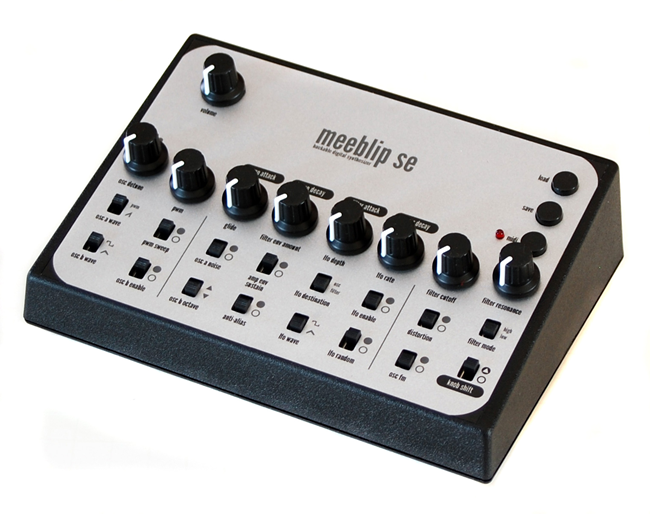
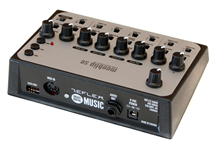
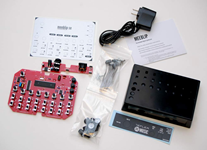
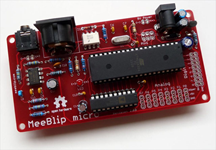
The Meeblip is a truly great little synthesizer. It's offered in
two main versions: the desktop version with many knobs (yes, I have
both), and a micro version which is quite a bit cheaper than
anything else out there, and which is meant to be controlled via
MIDI. The micro is what Andrew Duthie used in his Meeblipiator.
Of all the synthesizers, this is one of the easiest to assemble,
and the simplest to use. There's no real memory (just a recall on
the main SE), and you can choose just how much you want to
assemble. It has a sometimes raw, sometimes fat, always fun and
sometimes even lo-fi sound. You can hear some sequences here.
As a first kit, I can't recommend the Meeblip enough.
Unless you're comfortable with MIDI controller messages, get the
SE.
Shruthi-1 (and options) (Open Source)
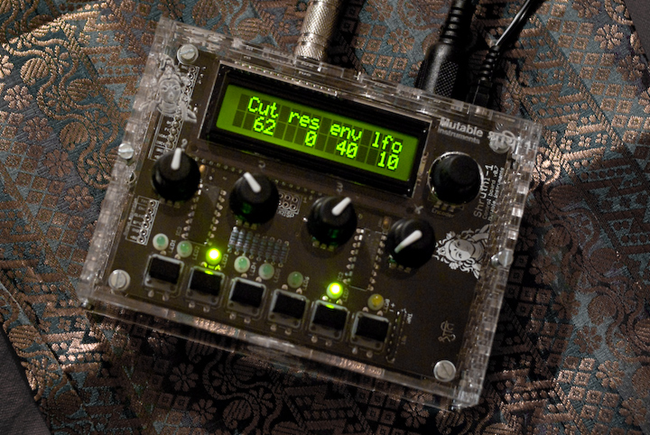
Another really fun synthesizer is the Shruthi-1. This isn't a
single synth, but rather a collection of main boards and filter
options. There are some pre-identified kits with everything you
need (minus some resistors and capacitors you'll need to order
using their bill of materials), and some others which are just
different filter boards you can swap in to work with the main
board. It's very customizable. I recently ordered (and received)
the 4-pole mission kit as well as the Polivoks PCB pair and an enclosure. That'll make it possible for me to
build two different Shruthi-1s. The 4-pole kit will be easier
because it contains the harder to obtain parts, and the Polivoks
will be a good follow-on. They have an amazing number of different
filter boards, but be sure to read the information on each one
before ordering: some rely on out-of-production or very hard to
find parts.
The Shruthi-1 sounds great. Listen to the sounds to see if it's what you're
looking for. Remember that each filter sounds distinctly different.
Hackme Rockit (Open Source)
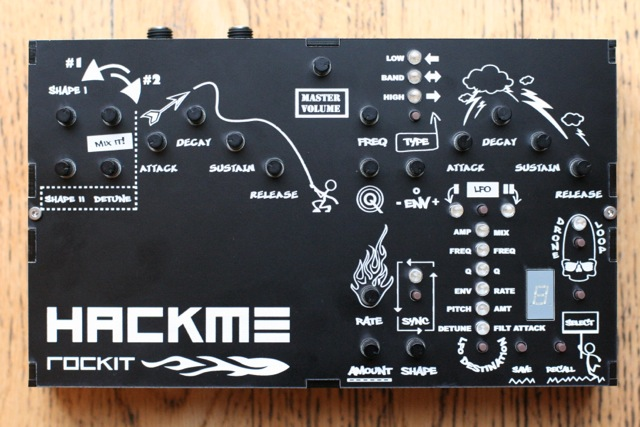
I recently purchased the case and PCB for one of these. I
already had many of the parts, and have some of the remaining ones
on order. This is another neat little AVR-based hybrid
analog/digital synthesizer. Unless you already have a huge
collection of some oddball values for resistors and whatnot, it'll
be cheaper for you to just purchase the full kit with all parts. I
decied on the larger Rockit, but they also have a smaller and less
expensive (but also enjoyable, from what I see) Sprockit
Synth.
This little guy sounds great, with a little
bit of 8bit goodness mixed in with some classic analog. I love it.
Speaking of 8bit goodness, you'll really love the next one.
SammichSID and MIDIBox SID (Open, with some restrictions)
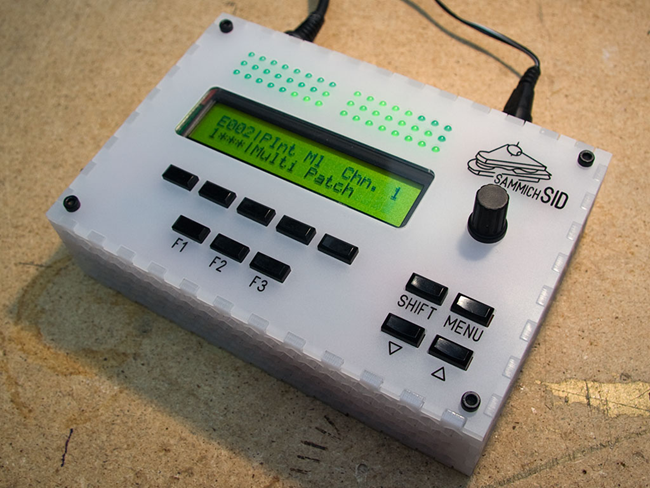
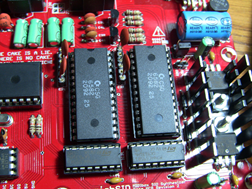
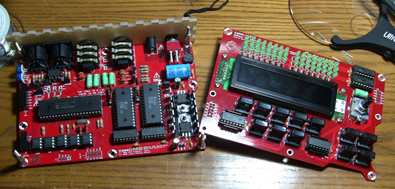
I have two SammichSID units. One is built (white/frost), the other (a black
and green one from a second run) is in a box waiting for me to
build it. These awesome little synthesizers each use two MOS SID
chips from the Commodore 64 and Commodore 128 computers. The sound is
awesome.
The SammichSID kits may no longer be available, but
the larger MIDIBox kits, which can hold more than two SID
chips, should still be available. Although not exactly Open Source
Hardware, the specifications and source code are all available, and
you can build them yourself. You can't do anything commercial,
however. The
sound of eight SID chips running is pretty epic, though.
MIDIbox isn't limited to SID synthesizers - they have
sequencers, mixers, FM synths and much more. It's a big DIY
community with great support.
PAIA FatMan
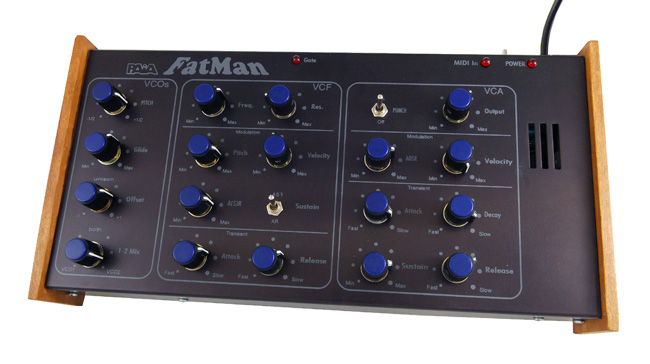
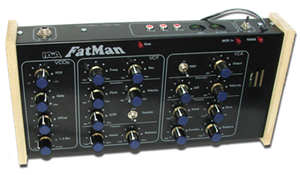
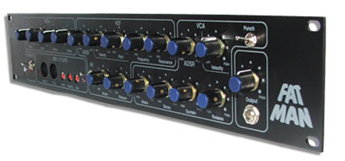
The PAIA FatMan is another nice little synthesizer, specifically
optimized for bass sounds in this case. This one can be built
either in tabletop for or rack-mount form, depending upon which
body you purchase for it. I don't have one of these yet, but it's
on my list. You'll find lots of mods on the web by people who have
come up with ways to add new and interesting features to this guy.
The Oakley TM3030
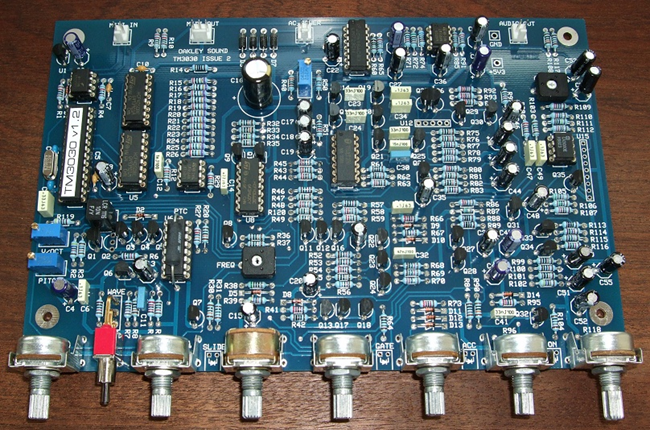
This is a midified Roland TB-303 clone which doesn't include a
case or front panel or case. You can design a front panel using
Front Panel Express or your own CNC rig if you have one, or even
just with sheet stock and a step drill. I have one of these boards
in my "to be built" cabinet.
Others
There are lots of other cool synthesizer kits out there. x0xb0x, the Monowave, the AVRSynth and ASM-2 and ASM-3 synthesizers, vacoloco (but
they're always out of stock) and many many more. Most of them
aren't really "kits", however. They're still very cool. In fact, if
the ASM-3 ever gets created (more of a semi modular synth) I'll be
all over it. Unfortunately, it's been "coming soon" for years
now.
This thread has a number of interesting ones,
mostly commercial, but some kits and open source as well.
Another area of synthesizer development, one which has a DIY
community far older than the MIDI synth module community, is in
modular and semi-modular synthesizers.
Modular and Semi-Modular Synthesizers
If you want to go hardcore, you can get into building modular
and semi-modular synths. These are generally not MIDI-compatible,
meaning they use the older standards of control voltages (CV) for
gate and pitch (and other) values. You can purchase a MIDI to CV
converter for a couple hundred bucks, but it's an added expense.
You can also build a CV keyboard or other controller device. Like I
said, more hardcore :)
Instead of using pre-set routing on the PCB or in
microcontroller firmware, modular synthesizers use patch cables to
route sound from one component to the next. You can add modules to
the chain as much as you'd like, giving you almost infinite sound
possibilities. Most of the classic synthesizer gurus like Isao
Tomita, Vangelis, and Jean Michel Jarre made good use of modular
and semi-modular synthesizers. You'll even find Deadmau5 tinkering with them.
Ray Wilson's Music From Outer Space
One of my favorite places to start is MFOS or Music From Outer
Space. Ray's kits aren't for beginners, but there are a couple on
there that come close, given that they include all the parts you
may need to get started. Most of his kits require you to source all
the components from Mouser or Digikey or similar, but the Weird Sound Generator (not a musical synth) is
available as a complete component kit. On the more musical (and
slightly more expensive side) his Sound Lab Mini Synth is also available as a
complete kit with components. In both cases, you'll need to
build a wooden case or find something else to house it.
I'm personally building a large synth which includes a Sound Lab Ultimate, an Ultimate Expander, and a Sound Lab Mini-Synth MARK II. Here are a
couple photos:
Here's one that Todd Fletcher built. He used two expanders and
one ultimate, so the configuration is a little different from what
I'll have.
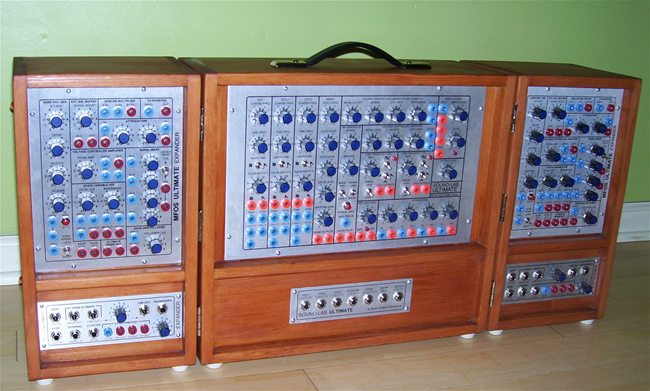
And here's my own work in progress for one of the three modules
that will be in my case:
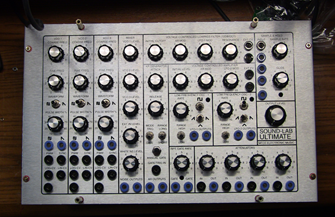
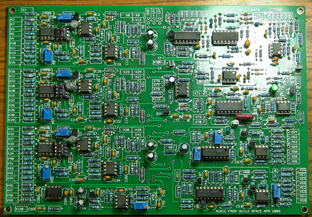
You can find all
my MFOS build posts using this tag.
PAIA

The Paia 9700 is a really need series of modules. They're
FracRak (Fractional Rack) format small modules with decent sound
and a really affordable price. The 9700s is the full kit shown
here, but PAIA sells a number of individual modules as well.
Doepfer

Most Doepfer modules aren't kits. However, they do
offer a DIY analog synthesizer core which you can use
in your own synthesizer creations. You don't need to do any
building of the board itself, just wiring to a lot of controls,
patch bays, etc. Just look at this lovely synthesizer made with the
synth cores, and a lot of hard work.
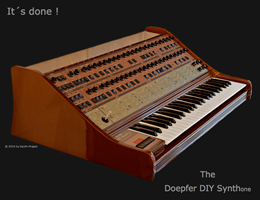
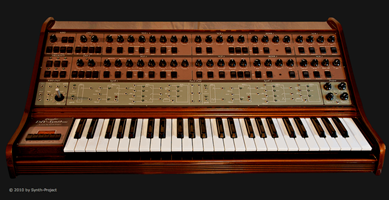
Doepfer has a number of other DIY parts for building your own
devices. They sell many different DIN and USB MIDI interfaces,
keybeds, controllers, and more. In the US, you can find most of
their things at Analog Haven.
Oakley Modular
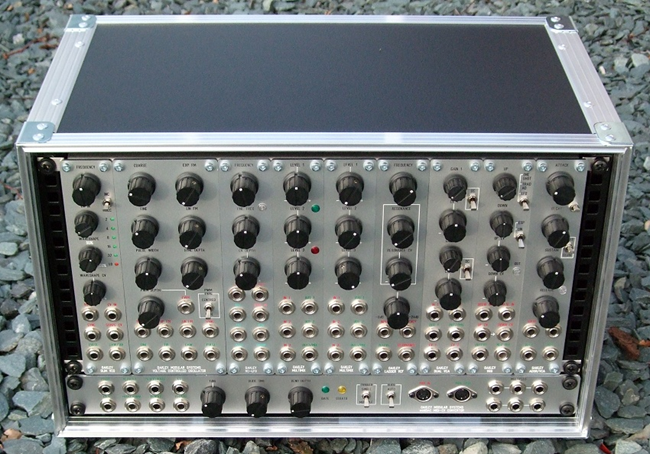
Oakley has a ton of different modules available primarily in PCB
form. According to their site:
An example of a small but powerful Oakley modular system
built into a 6U high 19" rack using natural finish Scheaffer
panels. The system comprises of SVCO-B, VCO, VC-LFO, Multimix (x2),
Transistor Superladder VCF, D-VCA, VRG and ADSR/VCA. The 19" wide
module underneath the 5U high modules is a midiDAC rack.
Many Many Others
One of the best places to learn about new DIY kits is at electro-music.com, that's where you can also
talk with others who have built kits, get support, and more. They
even have a store which has a limited number of boards and other
parts.
Hacking Commercial Synthesizers
There are also lots of commercial synthesizers that can be
hacked and modified. Just about anything can be modified, but some
were designed with that in mind. Here are a couple.
The NTH Open Source Hardware Music Synthesizer
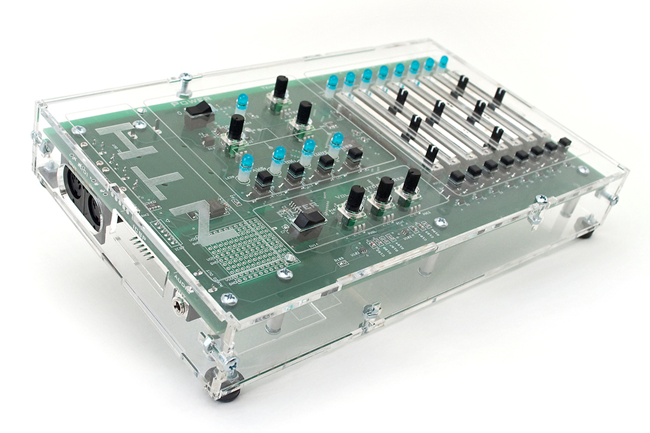
This one isn't a kit, but it's Open Source Hardware. I didn't
get in on this when it was on Kickstarter, but really hope it comes
up for regular commercial purchases in kit form. Of course, it's
open hardware, so there's nothing stopping me or anyone else from
having a PCB made. Note that it is hackable and even includes
prototyping areas on the board.
Korg Monotron, Monotron Delay, and Monotron Duo
I have a Duo and a Delay. They're fun little devices, but for
your money ($50 each), you can do better with one of the other
alternatives on this list. However, they are true 100% analog
synthesizers, designed in such a way as to allow you to hack them
with additional controls, and even MIDI.
Here are a few photos of my Monotron Delay hacked open. Click to
enlarge.
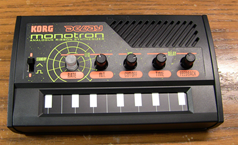
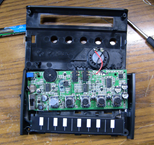
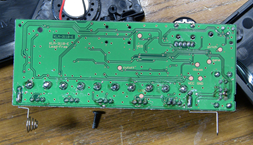
The larger (and more expensive) Korg Monotribe is also somewhat
hackable, mainly to add in MIDI support.
Go build something
A few evenings with a soldering iron and then you have a real
musical instrument you can play or just mess around with. It's fun
to build, and even more satisfying to use something you built with
your own hands.
I'm always on the lookout for new kits. If you know of
some that I haven't mentioned here, please let me
know!
